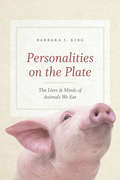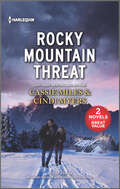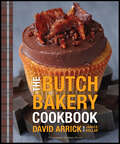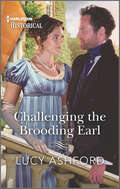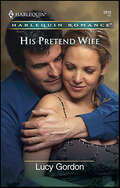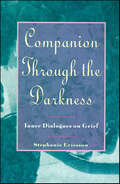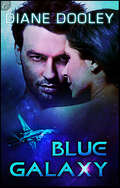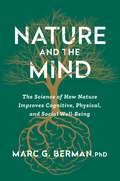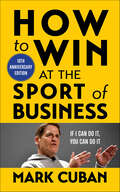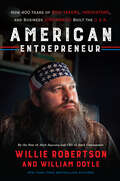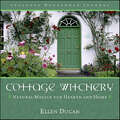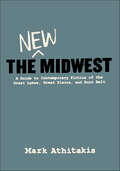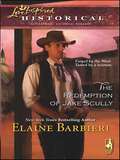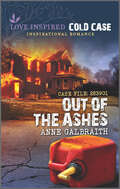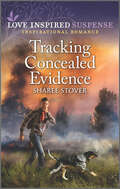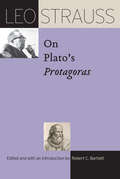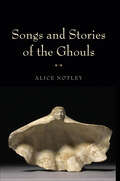- Table View
- List View
Personalities on the Plate: The Lives & Minds of Animals We Eat
by Barbara J. KingIn recent years, scientific advances in our understanding of animal minds have led to major changes in how we think about, and treat, animals in zoos and aquariums. The general public, it seems, is slowly coming to understand that animals like apes, elephants, and dolphins have not just brains, but complicated inner and social lives, and that we need to act accordingly. Yet that realization hasn’t yet made its presence felt to any great degree in our most intimate relationship with animals: at the dinner table. Sure, there are vegetarians and vegans all over, but at the same time, meat consumption is up, and meat remains a central part of the culinary and dining experience for the majority of people in the developed world. With Personalities on the Plate, Barbara King asks us to think hard about our meat eating--and how we might reduce it. But this isn’t a polemic intended to convert readers to veganism. What she is interested in is why we’ve not drawn food animals into our concern and just what we do know about the minds and lives of chickens, cows, octopuses, fish, and more. Rooted in the latest science, and built on a mix of firsthand experience (including entomophagy, which, yes, is what you think it is) and close engagement with the work of scientists, farmers, vets, and chefs, Personalities on the Plate is an unforgettable journey through the world of animals we eat. Knowing what we know--and what we may yet learn--what is the proper ethical stance toward eating meat? What are the consequences for the planet? How can we life an ethically and ecologically sound life through our food choices? We could have no better guide to these fascinatingly thorny questions than King, whose deep empathy embraces human and animal alike. Readers will be moved, provoked, and changed by this powerful book.
Rocky Mountain Threat
by Cassie Miles Cindi MyersDanger in the RockiesMountain Blizzard by Cassie Miles After his ex-wife witnesses a murder, security specialist Sean Timmons steps in to be her bodyguard. One look at investigative reporter Emily Peterson and Sean is reminded why he fell in love with her. Now trapped in the Colorado mountains by a blizzard, the former Mr. and Mrs. Timmons rediscover their passion. But a cold-blooded killer is waiting to stop them from uncovering evidence—and ever saying "I do" again.Snowbound Suspicion by Cindi Myers Bette Fuller has come to Eagle Mountain, Colorado, looking for a fresh start. So when she becomes the target of a serial killer, the wedding caterer refuses to be anyone&’s victim. Turning to groomsman and US Marshal Cody Rankin for help becomes personal for Bette. Cody is attractive, protective—and more trustworthy than she wants to admit. But can they stay one step ahead of the Ice Cold Killer…?USA TODAY Bestselling Author Cassie Miles2 Thrilling StoriesMountain Blizzard and Snowbound Suspicion
The Butch Bakery Cookbook
by David Arrick Janice KollarThis is not your mother's cupcake cookbookThe Butch Bakery does cupcakes like nobody else. You can forget the pretty sparkles and the flowers on top, forget the pastel cupcakes for Easter or Halloween. These aren't cupcakes for little kids, but grown-up cupcakes full of contemporary, inventive flavors—like bacon, whiskey, coffee, and cayenne pepper. The Butch Bakery Cookbook offers cupcakes for the twenty-first century—like a cupcake imbued with two different liqueurs or a devil's food cake made truly diabolical with a dose of chili powder. These are serious sweets. They're delightfully different and dangerously delicious. Author David Arrick has received tremendous media coverage since opening Butch BakeryPerfect for dessert or cupcake lovers who are tired of the same old vanilla or chocolate cake with icing on topFor anyone who wants a dessert that breaks the mold and challenges the taste buds with modern flavors and inspired ingredients, The Butch Bakery Cookbook delivers the goods—seriously.
Challenging the Brooding Earl
by Lucy AshfordA Regency enemies-to-lovers story Her biggest test? Not falling for her enigmatic rival! Upon learning her family are the rightful heirs to Hythe Hall, Merryn Hythe must claim her ancestral home back from the brooding Earl of Marchwood. The earl makes it clear he&’s not used to losing challenges, but Merryn will show him he&’s met his match! Yet as she starts to see the vulnerability beneath his proud exterior, their unexpected attraction could lead to more than just a battle of wills… From Harlequin Historical: Your romantic escape to the past.
His Pretend Wife
by Lucy GordonAndrew Blake is the heart surgeon who will operate on Elinor's daughter, Hetta. He's also the man Elinor nearly married….Andrew has helped them so much—saving Hetta's life and finding them a new place to live. Elinor finds she still loves Andrew, but didn't she lose her right to his love years ago? Now single dad Andrew asks Elinor to live in his home, and become his housekeeper and childminder, almost like a pretend wife. Elinor agrees—for all their sakes—but can she ever be Mrs. Blake for real…?
Her Mountain Protector
by Jenna Ryan Alana MatthewsShelter from the stormCold Case Cowboy by Jenna Ryan For Nick Law, the case of the Snow Globe Killer has grown as cold as the snow-covered Colorado mountains. Then Sasha Myer arrives—fitting the profile of every victim. When an avalanche traps her on Smoking Gun Pass, Sasha wishes she&’d heeded Nick&’s warning. Now the two are stranded in a blizzard, and Nick is all that stands between a cold-blooded predator and his prey…A Wanted Man by Alana Matthews Nothing would stop US marshal Harlan Cole from capturing an escaped fugitive. Not even having to partner with his ex, Wyoming deputy Callie Glass. The deeper they ride into the mountains, the more Harlan has to protect Callie from the chilling secrets of her past. Sensing the rekindling of an old flame, Harlan now has one goal: keeping Callie alive long enough to win her back. Previously published as Cold Case Cowboy and A Wanted Man
Companion Through The Darkness: Inner Dialogues on Grief
by Stephanie EricssonAs a result of her own experience with many kind of loss, Stephanie Ericsson offers an intimate, profoundly touching guide for those in grief, legitimizing the complex and often taboo emotions we all feel when loss transforms our lives. In Companion Through the Darkness, Stephanie Ericsson defines grief as "the constant reawakening that things are now different." Using a very simple format -- which combines excerpts from her own diary writings with brief essays -- she vividly speaks the language of loss and captures the contradictory, wrenching, and chaotic emotions of grief. The book can be opened at any point to chapters no more than a few pages long on such themes as: Abandonment: The sudden state I am forced into. I no longer belong to you. I no longer belong to anyone. Rage: The state I use to survive seemingly moments of intolerable pain. Humor: The backside of agony. Pity: The look on people's faces when they haven't a clue what to say to me. Transition: The moments, strung out over months, when I know I am no longer the woman I was, but not quite the woman I am becoming. The result is compelling, intimate, and heartbreakingly truthful -- a book that promises to be enormously sought-after support and touchstone for all those making their own journey through grief.
Blue Galaxy
by Diane DooleyFalling in love is easy; staying alive long enough to enjoy it just might be impossible.Javan Rhodes, the hard-drinking, disreputable captain of space freighter The Kypris, took a mission to save himself from hitting the bottom of the food chain. Transporting Sola, a beautiful young aristocrat, from Earth to an unknown destination on the outer rim of the colonies is lucrative, but also highly illegal.As tough as it is to evade both the law and the lawless, the hardest part of the job is not falling in love with his irresistible cargo. Just as he decides that he will never be able to hand her over to the warlord she must marry, he discovers that Sola has been playing a very dangerous game-one that could not only cost them their lives, but could also affect the balance of power in an increasingly dangerous universe.22,000 words
On Not Knowing: How to Love and Other Essays
by Emily OgdenA beautifully written suite of personal essays on the value of not knowing. Moments of clarity are rare and fleeting; how can we become comfortable outside of them, in the more general condition of uncertainty within which we make our lives? Written by English professor Emily Ogden while her children were small, On Not Knowing forays into this rich, ambivalent space. Each of her sharply observed essays invites the reader to think with her about questions she can’t set aside: not knowing how to give birth, to listen, to hold it together, to love. Unapologetically capacious in her range of reference and idiosyncratic in the canon she draws on, Ogden moves nimbly among the registers of experience, from the operation of a breast pump to the art of herding cattle; from one-night stands to the stories of Edgar Allan Poe; from kayaking near a whale to a psychoanalytic meditation on drowning. Committed to the accumulation of knowledge, Ogden nonetheless finds that knowingness for her can be a way of getting stuck, a way of not really living. Rather than the defensiveness of willful ignorance, On Not Knowing celebrates the defenselessness of not knowing yet—possibly of not knowing ever. Ultimately, this book shows how resisting the temptation of knowingness and embracing the position of not knowing becomes a form of love.
Nature and the Mind: The Science of How Nature Improves Cognitive, Physical, and Social Well-Being
by Marc BermanFrom the acclaimed founder of environmental neuroscience, Dr. Marc Berman, comes a groundbreaking guide that reveals how interacting with nature can be the secret to improved mental and physical health.Dr. Marc Berman, the pioneering creator of the field of environmental neuroscience, has discovered the surprising connection between mind, body, and environment, with a special emphasis on the natural environment. He has devoted his life to studying it. If you sometimes feel drained, distracted, or depressed, Dr. Berman has identified the elements of a &“nature prescription&” that can boost your energy, sharpen your focus, change your mood, and improve your mental and physical health. He also reveals how central attention is to all of these functions, and how interactions with nature can restore it. Nature and the Mind is both an introduction to a revolutionary new scientific field and a helpful guide to better living. In these pages, he draws on his original research and research from others and shares life-altering findings such as: -Just eleven more trees on your street can decrease cardio-metabolic disorders like stroke, diabetes, and heart disease. -A short walk in nature can improve attention by almost twenty percent, decrease depression symptoms, and make people feel more spiritual and self-reflective. -More greenspace around schools and homes is related to better school performance, reduced crime, and improved working memory. -Many of these effects can be achieved even if you don&’t like nature. With an engaging and approachable style, Dr. Berman offers the nature prescription for physical health, mental health, and social health. Importantly, you don&’t have to pack up your house and move to the country to participate. The nature prescription includes practical ways to bring the outside indoors and to &“naturize&” our spaces, no matter where you live. The positive effects of nature don&’t just end at the individual; contact with nature can make people more caring towards one another, promote economic and racial justice, encourage people to care more for the environment, and more. This groundbreaking guide explains why and how nature is good for our brains and bodies and gives us a window into fundamental aspects of our psychology and physiology that can be improved through interactions with nature.
How to Win at the Sport of Business
by Mark CubanThe Shark Tank celebrity reveals how he became one of the world’s wealthiest and most influential businessmen.“Cuban [explains] what it means to have ‘the edge,’ the necessary drive to forego the confines of a comfortable job, triumph over setbacks, and build a successful company.” —Business Insider“Exceeded . . . expectations.” —Huffington PostIn How to Win at the Sport of Business, Mark Cuban collects his greatest lessons on what it takes to become a thriving entrepreneur. Drawing upon his profound insider knowledge, Cuban offers unconventional business tips and tells his stunning rags-to-riches tale from selling powdered milk and sleeping on friends’ couches to owning his own company and becoming a multi-billion-dollar success story. Mark shows how he puts his own advice into practice and how entrepreneurs at any stage of their careers can outmaneuver their competitors.
American Entrepreneur: How 400 Years of Risk-Takers, Innovators, and Business Visionaries Built the U.S.A.
by William Doyle Willie RobertsonAmerica is the ultimate start-up venture – and these are the heroes who made it happenThe history of the United States is, to a remarkable degree, the story of its entrepreneurs, those daring movers and shakers who dreamed big and risked everything to build better lives for themselves and their fellow Americans. Drawing on his own family's remarkable journey, Duck Commander CEO and star of the blockbuster Duck Dynasty series Willie Robertson tells the captivating true tale of the visionaries and doers who have embodied the American dream.We begin with the first American entrepreneurs, the Native Americans, who established a highly sophisticated commercial network across the land in the precolonial days. The original Founding Father, George Washington, was also a founding entrepreneur, at the head of a thriving agribusiness venture that gave him the executive skills to steer the nation through the darkest hours of the American Revolution. Then, of course, there were the mega entrepreneurs, legendary figures like Astor, Vanderbilt, Carnegie, and Rockefeller, who transformed America, connected the country with miles of railroad track and supplied the fuel and steel that would help make America the most powerful nation on earth. And in recent years, business visionaries like Jobs, Gates, and Zuckerberg—not to mention the thousands of equally vital, yet smaller-scale, operators who spring up every year—have ushered America into the twenty-first century.American Entrepreneur also relates the story of the Robertson family business, telling how Willie’s family turned a humble regional duck call manufacturer, founded by his father, Phil, into an international powerhouse brand. From a young age, Willie had the entrepreneurial bug, buying candy in bulk and hawking it on the school bus. He did special orders and earned a small fortune for a ten-year-old—until he was hauled into the principal’s office and told to knock it off. So he transferred his focus to Phil’s fledgling business, helping in whatever way he could, from folding endless numbers of cardboard boxes to acting as the company’s customer service department—though he still wasn’t out of grade school. Willie helped build Duck Commander, which he now runs, into a worldwide brand, culminating in the mega success of the Duck Dynasty television show.American Entrepreneur tells a most American tale, of those among us who, through their vision, ingenuity, and good old-fashioned hard work, made something that changed the world.
Cottage Witchery: Natural Magick for Hearth and Home
by Ellen Dugan“This guide will appeal to a broad audience, from the serious witch to . . .the newbie seeking an alternative kind of feng shui.” —Publishers WeeklyEllen Dugan, the award-winning author of Garden Witchery, is the ideal guide to show us how to bring the beauty of nature and its magickal energies indoors. Using common household and outdoor items—such as herbs, spices, dried flowers, plants, stones, and candles—she offers a down-to-earth approach to creating an enchanted home.From specialized spells and charms to kitchen conjuring and color magick, this hands-on guide teaches Witches of all levels how to strengthen a home’s aura and energy. Readers will learn how to use begonias and lilacs for protection, dispel bad vibes with salt and lemon, perform tea leaf readings, bless the home with fruit, invite the help of home faeries, perform houseplant magick, and create a loving home for the whole family.“The queen of everyday witchery has outdone herself with this tome.” —Retailing Insight
The New Midwest: A Guide to Contemporary Fiction of Great Lakes, Great Plains, and Rust Belt
by Mark Athitakis&“Dives deep into Midwestern literature, unpacking the mythology of the region and how today&’s writers are complicating our simple idea of the Heartland.&” —Huffington Post In the public imagination, Midwestern literature has not evolved far beyond heartland laborers and hardscrabble immigrants of a century past. But as the region has changed, so, in many ways, has its fiction. In this book, the author explores how shifts in work, class, place, race, and culture has been reflected or ignored by novelists and short story writers. From Marilynne Robinson to Leon Forrest, Toni Morrison to Aleksandar Hemon, Bonnie Jo Campbell to Stewart O&’Nan this book is a call to rethink the way we conceive Midwestern fiction, and one that is sure to prompt some new must-have additions to every reading list. &“Using the lens of novels and short stories published over the past 30 or so years, Athitakis seeks to illuminate the ways we still lean on literary mythology of the Midwest when it comes to defining the region.&” —Chicago Tribune &“[The New Midwest] rightly praises the Midwestern novels of Marilynne Robinson, Jeffrey Eugenides, Toni Morrison and Jonathan Franzen, but also points out works of comparable merit that warrant rediscovery.&” —The Washington Post &“The New Midwest is a crisp, engaging tip sheet and guide for further reading.&” —Milwaukee Journal-Sentinel &“A journey through the Midwest and through some key works by writers [Athitakis] thinks are most effectively using the region in their fiction.&” —Kirkus Reviews
Understanding Climate Change through Religious Lifeworlds
by David L. HabermanHow can religion help to understand and contend with the challenges of climate change?Understanding Climate Change through Religious Lifeworld,edited by David Haberman, presents a unique collection of essays that detail how the effects of human-related climate change are actively reshaping religious ideas and practices, even as religious groups and communities endeavor to bring their traditions to bear on mounting climate challenges.People of faith from the low-lying islands of the South Pacific to the glacial regions of the Himalayas are influencing how their communities understand earthly problems and develop meaningful responses to them. This collection focuses on a variety of different aspects of this critical interaction, including the role of religion in ongoing debates about climate change, religious sources of environmental knowledge and how this knowledge informs community responses to climate change, and the ways that climate change is in turn driving religious change.Understanding Climate Change through Religious Lifeworlds offers a transnational view of how religion reconciles the concepts of the global and the local and influences the challenges of climate change.
At Her Pleasure
by Cindi MyersNo more Ms. Nice Girl. Thanks to Nicole Howard's accommodating ways, her life has delivered a whole lot of disappointment. Armed with a pirate queen's autobiography-aka a girl's guide to seduction and sexual empowerment-Nicole heads to the Caribbean determined to unleash her inner diva for a steamy adventure.Hottie Ian Marshall and an almost-deserted island are the perfect ingredients for a little no-strings action.In fact, this fling is giving her everything she ever wanted... and then some. Once their sensual games are over, however, will she be able to walk away from the best sex...ever?
Hunted in Alaska
by Jill Elizabeth NelsonAn artist must think fast to survive when criminals invade her peace in the Alaskan wilderness in this inspirational romantic suspense thriller.No legitimate plane should be near Hayley Brent’s remote Alaskan cabin this time of year—and her fears are confirmed when gunshots fly her way. When one of the weapon-smugglers on board claims to be an undercover ATF agent, Hayley must decide fast whether she believes him because with vicious pursuers and a blizzard closing in, Sean O’Keefe may be her only hope of surviving . . .From Love Inspired Suspense: Courage. Danger. Faith.
The Redemption of Jake Scully
by Elaine BarbieriThe Loner and the Lady Saloon owner Jake Scully knew his rough frontier town was no place for a delicate lady like Lacey Stewart. Once, he'd sheltered her from harm. Ten years later, Lacey was no longer a frightened girl, but a woman grown. She deserved a respectable man, not a jaded rogue like Jake. And Jake's "delicate lady" had a mind of her own-with ideas that included introducing Jake to a life of love and faith, no matter how hard he tried to keep his distance. But when danger began stalking her again, Jake realized the only safe place for Lacey was by his side.
Meantone Temperaments on Lutes and Viols (Publications of the Early Music Institute)
by David DolataWritten for musicians by a musician, Meantone Temperaments on Lutes and Viols demystifies tuning systems by providing the basic information, historical context, and practical advice necessary to easily achieve more satisfying tuning results on fretted instruments. Despite the overwhelming organological evidence that many of the finest lutenists, vihuelists, and viola da gamba players in the Renaissance and Baroque eras tuned their instruments in one of the meantone temperaments, most modern early instrument players today still tune to equal temperament. In this handbook richly supplemented with figures, diagrams, and music examples, historical performers will discover why temperaments are necessary and how they work, descriptions of a variety of temperaments, and their application on fretted instruments. This technical book provides downloadable audio tracks and other tools for fretted instrument players to achieve more stable consonances, colorful dissonances, and harmonic progressions that vividly propel the music forward.
The Cowboy and the Angel
by Marin Thomas'Tis the season...for miracles? Renée Sweeney will do whatever it takes to keep a roof over the heads of Detroit's street kids. Even if it means stepping in front of a ten-ton wrecking ball aimed at their temporary home. And especially if it means clashing with gorgeous corporate cowboy Duke Dalton. To Duke, the blue-eyed blonde seems more like an angel than a social worker. Until he discovers a group of runaways camping out in his warehouse! The Tulsa businessman came to set up shop in a new town, not provide free housing for the masses. But Renée and the kids are making him rethink his bottom line...and what the spirit of the Christmas season really means.
Out of the Ashes
by Anne GalbraithHe was framed for murder…Now can he convince her of his innocence?Sheriff Sarah Winfrey has seen her share of men claiming not to be guilty. Yet something in Lanford Davies’s haunted gray eyes convinces Sarah to investigate the fire that killed Lanford’s family—and sent him to prison for eighteen years. But if Lanford is innocent, that means a killer is still out there. Can they sift through the ashes of a long-ago past to find the truth…without getting burned?
Tracking Concealed Evidence
by Sharee StoverTargeted by a murderous politician, a detective teams up with a CSI to prove his guilt, sharing their faith—and something more—in this romantic suspense.To salvage his reputation, former forensic entomologist Jamie Dyer and his cadaver dog search for clues in a dismissed homicide—and find the victim’s sister, Detective Shaylee Adler, buried alive.Convinced her senator brother-in-law is behind the attack on her and her sister’s disappearance, Shaylee needs Jamie’s expertise. But can they uncover a deadly conspiracy before the killer buries the case—and them—for good?From Love Inspired Suspense: Courage. Danger. Faith.
Leo Strauss on Plato’s Protagoras (The Leo Strauss Transcript Series)
by Leo StraussA transcript of Leo Strauss’s key seminars on Plato’s Protagoras. This book offers a transcript of Strauss’s seminar on Plato’s Protagoras taught at the University of Chicago in the spring quarter of 1965, edited and introduced by renowned scholar Robert C. Bartlett. These lectures have several important features. Unlike his published writings, they are less dense and more conversational. Additionally, while Strauss regarded himself as a Platonist and published some work on Plato, he published little on individual dialogues. In these lectures Strauss treats many of the great Platonic and Straussian themes: the difference between the Socratic political science or art and the Sophistic political science or art of Protagoras; the character and teachability of virtue, its relation to knowledge, and the relations among the virtues, courage, justice, moderation, and wisdom; the good and the pleasant; frankness and concealment; the role of myth; and the relation between freedom of thought and freedom of speech. In these lectures, Strauss examines Protagoras and the sophists, providing a detailed discussion of Protagoras as it relates to Plato’s other dialogues and the work of modern thinkers. This book should be of special interest to students both of Plato and of Strauss.
Songs and Stories of the Ghouls (Wesleyan Poetry Series)
by Alice NotleyLeft dead after our cultures were broken by triumphant enemies, our stories changed to suit others. We now change them again to suit ourselves. Songs and Stories of the Ghouls purports to give power to the dead—voices to the victims of genocide both ancient and contemporary—and presence to women. Medea did not kill her sons; Dido founds a city, over and over again, the city of the present author's poetry. In these poems the poet asserts that though her art comes from a tradition as broken as Afghanistan's statuary, there is always a culture to pass on to one's children, and one is always involved in doing so. We are the ghouls, the drinkers of the blood-sacs, and we insist that we are alive.
Oscar Wilde Prefigured: Queer Fashioning and British Caricature, 1750–1900
by Dominic Janes“I do not say you are it, but you look it, and you pose at it, which is just as bad,” Lord Queensbury challenged Oscar Wilde in the courtroom—which erupted in laughter—accusing Wilde of posing as a sodomite. What was so terrible about posing as a sodomite, and why was Queensbury’s horror greeted with such amusement? In Oscar Wilde Prefigured, Dominic Janes suggests that what divided the two sides in this case was not so much the question of whether Wilde was or was not a sodomite, but whether or not it mattered that people could appear to be sodomites. For many, intimations of sodomy were simply a part of the amusing spectacle of sophisticated life.Oscar Wilde Prefigured is a study of the prehistory of this “queer moment” in 1895. Janes explores the complex ways in which men who desired sex with men in Britain had expressed such interests through clothing, style, and deportment since the mid-eighteenth century. He supplements the well-established narrative of the inscription of sodomitical acts into a homosexual label and identity at the end of the nineteenth century by teasing out the means by which same-sex desires could be signaled through visual display in Georgian and Victorian Britain. Wilde, it turns out, is not the starting point for public queer figuration. He is the pivot by which Georgian figures and twentieth-century camp stereotypes meet. Drawing on the mutually reinforcing phenomena of dandyism and caricature of alleged effeminates, Janes examines a wide range of images drawn from theater, fashion, and the popular press to reveal new dimensions of identity politics, gender performance, and queer culture.
